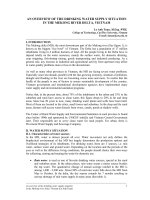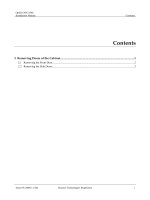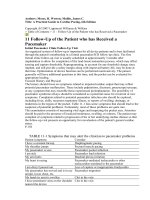Tài liệu Official Journal of the European Union docx
Bạn đang xem bản rút gọn của tài liệu. Xem và tải ngay bản đầy đủ của tài liệu tại đây (220.77 KB, 54 trang )
30.4.2004 Official Journal of the European Union L 139/1
EN
I
(Acts whose publication is obligatory)
REGULATION (EC) No 852/2004 OF THE EUROPEAN PARLIAMENT
AND OF THE COUNCIL
of 29 April 2004
on the hygiene of foodstuffs
THE EUROPEAN PARLIAMENT AND THE COUNCIL OF THE EUROPEAN UNION,
Having regard to the Treaty establishing the European Community, and in particular Articles 95
and 152(4)(b) thereof,
Having regard to the proposal from the Commission
1
,
Having regard to the Opinion of the Economic and Social Committee
2
,
Having consulted the Committee of the Regions,
Acting in accordance with the procedure laid down in Article 251 of the Treaty
3
,
1
OJ C 365 E, 19.12.2000, p. 43.
2
OJ C 155, 29.5.2001, p. 39.
3
Opinion of the European Parliament of 15 May 2002 (OJ C 180 E, 31.7.2003, p. 267),
Council Common Position of 27 October 2003 (OJ C 48 E, 24.2.2004, p. 1), Position of the
European Parliament of 30 March 2004 (not yet published in the Official Journal) and
Council Decision of 16 April 2004.
Whereas:
(1) The pursuit of a high level of protection of human life and health is one of the fundamental
objectives of food law, as laid down in Regulation (EC) No 178/2002
1
. That Regulation also
lays down other common principles and definitions for national and Community food law,
including the aim of achieving free movement of food within the Community.
(2) Council Directive 93/43/EEC of 14 June 1993 on the hygiene of foodstuffs
2
laid down the
general rules of hygiene for foodstuffs and the procedures for verification of compliance with
these rules.
(3) Experience has shown that these rules and procedures constitute a sound basis for ensuring
food safety. In the context of the common agricultural policy, many Directives have been
adopted to establish specific health rules for the production and placing on the market of the
products listed in Annex I to the Treaty. These health rules have reduced trade barriers for the
products concerned, contributing to the creation of the internal market while ensuring a high
level of protection of public health.
(4) With regard to public health, these rules and procedures contain common principles, in
particular in relation to the manufacturers' and competent authorities' responsibilities,
structural, operational and hygiene requirements for establishments, procedures for the
approval of establishments, requirements for storage and transport and health marks.
1
Regulation (EC) No 178/2002 of the European Parliament and of the Council of
28 January 2002 laying down the general principles and requirements of food law,
establishing the European Food Safety Authority and laying down procedures in matters of
food safety (OJ L 31, 1.2.2002, p. 1). Regulation as amended by Regulation (EC)
No 1642/2003 (OJ L 245, 29.9.2003, p. 4).
2
OJ L 175, 19.7.1993, p. 1. Directive as amended by Regulation (EC) No 1882/2003 of the
European Parliament and of the Council (OJ L 284, 31.10.2003, p. 1).
(5) These principles constitute a common basis for the hygienic production of all food, including
products of animal origin listed in Annex I to the Treaty.
(6) In addition to this common basis, specific hygiene rules are necessary for certain foodstuffs.
Regulation (EC) No /2004 of the European Parliament and of the Council
of laying down specific hygiene rules for food of animal origin
1
lays down these
rules.
(7) The principal objective of the new general and specific hygiene rules is to ensure a high level
of consumer protection with regard to food safety.
(8) An integrated approach is necessary to ensure food safety from the place of primary
production up to and including placing on the market or export. Every food business operator
along the food chain should ensure that food safety is not compromised.
(9) Community rules should not apply either to primary production for private domestic use, or to
the domestic preparation, handling or storage of food for private domestic consumption.
Moreover, they should apply only to undertakings, the concept of which implies a certain
continuity of activities and a certain degree of organisation.
1
See page of this Official Journal.
(10) Food hazards present at the level of primary production should be identified and adequately
controlled to ensure the achievement of the objectives of this Regulation. However, in the
case of the direct supply of small quantities of primary products, by the food business
operator producing them, to the final consumer or to a local retail establishment, it is
appropriate to protect public health through national law, in particular because of the close
relationship between the producer and the consumer.
(11) The application of hazard analysis and critical control point (HACCP) principles to primary
production is not yet generally feasible. However, guides to good practice should encourage
the use of appropriate hygiene practices at farm level. Where necessary, specific hygiene
rules for primary production should supplement these guides. It is appropriate for the hygiene
requirements applicable to primary production and associated operations to differ from those
for other operations.
(12) Food safety is a result of several factors: legislation should lay down minimum hygiene
requirements; official controls should be in place to check food business operators'
compliance and food business operators should establish and operate food safety programmes
and procedures based on the HACCP principles.
(13) Successful implementation of the procedures based on the HACCP principles will require the
full cooperation and commitment of food business employees. To this end, employees should
undergo training. The HACCP system is an instrument to help food business operators attain
a higher standard of food safety. The HACCP system should not be regarded as a method of
self-regulation and should not replace official controls.
(14) While the requirement of establishing procedures based on the HACCP principles should not
initially apply to primary production, the feasibility of its extension will be one element of the
review that the Commission will carry out following implementation of this Regulation. It is,
however, appropriate for Member States to encourage operators at the level of primary
production to apply such principles as far as possible.
(15) The HACCP requirements should take account of the principles contained in the Codex
Alimentarius. They should provide sufficient flexibility to be applicable in all situations,
including in small businesses. In particular, it is necessary to recognise that, in certain food
businesses, it is not possible to identify critical control points and that, in some cases, good
hygienic practices can replace the monitoring of critical control points. Similarly, the
requirement of establishing "critical limits" does not imply that it is necessary to fix a
numerical limit in every case. In addition, the requirement of retaining documents needs to be
flexible in order to avoid undue burdens for very small businesses.
(16) Flexibility is also appropriate to enable the continued use of traditional methods at any of the
stages of production, processing or distribution of food and in relation to structural
requirements for establishments. Flexibility is particularly important for regions that are
subject to special geographical constraints, including the outermost regions referred to in
Article 299(2) of the Treaty. However, flexibility should not compromise food hygiene
objectives. Moreover, since all food produced in accordance with the hygiene rules will be in
free circulation throughout the Community, the procedure allowing Member States to exercise
flexibility should be fully transparent. It should provide, where necessary to resolve
disagreements, for discussion within the Standing Committee on the Food Chain and
Animal Health established by Regulation (EC) No 178/2002.
(17) The setting of objectives such as pathogen reduction targets or performance standards may
guide the implementation of hygiene rules. It is therefore necessary to provide procedures for
that purpose. Such objectives would supplement existing food law, such as Council
Regulation (EEC) No 315/93 of 8 February 1993 laying down Community procedures for
contaminants in food
1
, which provides for the establishment of maximum tolerances for
specific contaminants, and Regulation (EC) No 178/2002, which prohibits the placing on the
market of unsafe food and provides a uniform basis for the use of the precautionary principle.
(18) To take account of technical and scientific progress, close and effective cooperation should be
ensured between the Commission and the Member States within the Standing Committee on
the Food Chain and Animal Health. This Regulation takes account of international
obligations laid down in the WTO Sanitary and Phytosanitary Agreement and the
international food safety standards contained in the Codex Alimentarius.
(19) The registration of establishments and the cooperation of food business operators are
necessary to allow the competent authorities to perform official controls efficiently.
(20) The traceability of food and food ingredients along the food chain is an essential element in
ensuring food safety. Regulation (EC) No 178/2002 contains rules to ensure the traceability
of food and food ingredients and provides a procedure for the adoption of implementing rules
to apply these principles in respect of specific sectors.
1
OJ L 37, 13.2.1993, p. 1. Regulation as amended by Regulation (EC) No 1882/2003.
(21) Food imported into the Community is to comply with the general requirements laid down in
Regulation (EC) No 178/2002 or satisfy rules that are equivalent to Community rules. The
present Regulation defines certain specific hygiene requirements for food imported into the
Community.
(22) Food exported to third countries from the Community is to comply with the general
requirements laid down in Regulation (EC) No 178/2002. The present Regulation defines
certain specific hygiene requirements for food exported from the Community.
(23) Scientific advice should underpin Community legislation on food hygiene. To this end,
the European Food Safety Authority should be consulted whenever necessary.
(24) Since this Regulation replaces Directive 93/43/EEC, the latter should be repealed.
(25) The requirements of this Regulation should not apply until all parts of the new legislation on
food hygiene have entered into force. It is also appropriate to provide for at least 18 months
to elapse between entry into force and the application of the new rules, to allow the affected
industries time to adapt.
(26) The measures necessary for the implementation of this Regulation should be adopted in
accordance with Council Decision 1999/468/EC of 28 June 1999 laying down the procedures
for the exercise of implementing powers conferred on the Commission
1
,
HAVE ADOPTED THIS REGULATION:
1
OJ L 184, 17.7.1999, p. 23.
CHAPTER I
GENERAL PROVISIONS
Article 1
Scope
1. This Regulation lays down general rules for food business operators on the hygiene of
foodstuffs, taking particular account of the following principles:
(a) primary responsibility for food safety rests with the food business operator;
(b) it is necessary to ensure food safety throughout the food chain, starting with primary
production;
(c) it is important, for food that cannot be stored safely at ambient temperatures, particularly
frozen food, to maintain the cold chain;
(d) general implementation of procedures based on the HACCP principles, together with the
application of good hygiene practice, should reinforce food business operators' responsibility;
(e) guides to good practice are a valuable instrument to aid food business operators at all levels of
the food chain with compliance with food hygiene rules and with the application of
the HACCP principles;
(f) it is necessary to establish microbiological criteria and temperature control requirements
based on a scientific risk assessment;
(g) it is necessary to ensure that imported foods are of at least the same hygiene standard as food
produced in the Community, or are of an equivalent standard.
This Regulation shall apply to all stages of production, processing and distribution of food and to
exports, and without prejudice to more specific requirements relating to food hygiene.
2. This Regulation shall not apply to:
(a) primary production for private domestic use;
(b) the domestic preparation, handling or storage of food for private domestic consumption;
(c) the direct supply, by the producer, of small quantities of primary products to the final
consumer or to local retail establishments directly supplying the final consumer;
(d) collection centres and tanneries which fall within the definition of food business only because
they handle raw material for the production of gelatine or collagen.
3. Member States shall establish, under national law, rules governing the activities referred to in
paragraph 2(c). Such national rules shall ensure the achievement of the objectives of this
Regulation.
Article 2
Definitions
1. For the purposes of this Regulation:
(a) "food hygiene", hereinafter called "hygiene", means the measures and conditions necessary to
control hazards and to ensure fitness for human consumption of a foodstuff taking into
account its intended use;
(b) "primary products" means products of primary production including products of the soil, of
stock farming, of hunting and fishing;
(c) "establishment" means any unit of a food business;
(d) "competent authority" means the central authority of a Member State competent to ensure
compliance with the requirements of this Regulation or any other authority to which that
central authority has delegated that competence; it shall also include, where appropriate, the
corresponding authority of a third country;
(e) "equivalent" means, in respect of different systems, capable of meeting the same objectives;
(f) "contamination" means the presence or introduction of a hazard;
(g) "potable water" means water meeting the minimum requirements laid down in
Council Directive 98/83/EC of 3 November 1998 on the quality of water intended for human
consumption
1
;
(h) "clean seawater" means natural, artificial or purified seawater or brackish water that does not
contain micro-organisms, harmful substances or toxic marine plankton in quantities capable
of directly or indirectly affecting the health quality of food;
(i) "clean water" means clean seawater and fresh water of a similar quality;
(j) "wrapping" means the placing of a foodstuff in a wrapper or container in direct contact with
the foodstuff concerned, and the wrapper or container itself;
(k) "packaging" means the placing of one or more wrapped foodstuffs in a second container, and
the latter container itself;
(l) "hermetically sealed container" means a container that is designed and intended to be secure
against the entry of hazards;
1
OJ L 330, 5.12.1998, p. 32. Directive as modified by Regulation (EC) No 1882/2003.
(m) "processing" means any action that substantially alters the initial product, including heating,
smoking, curing, maturing, drying, marinating, extraction, extrusion or a combination of those
processes;
(n) "unprocessed products" means foodstuffs that have not undergone processing, and includes
products that have been divided, parted, severed, sliced, boned, minced, skinned, ground, cut,
cleaned, trimmed, husked, milled, chilled, frozen, deep-frozen or thawed;
(o) "processed products" means foodstuffs resulting from the processing of unprocessed products.
These products may contain ingredients that are necessary for their manufacture or to give
them specific characteristics.
2. The definitions laid down in Regulation (EC) No 178/2002 shall also apply.
3. In the Annexes to this Regulation the terms "where necessary", "where appropriate", "adequate"
and "sufficient" shall mean respectively where necessary, where appropriate, adequate or sufficient
to achieve the objectives of this Regulation.
CHAPTER II
FOOD BUSINESS OPERATORS' OBLIGATIONS
Article 3
General obligation
Food business operators shall ensure that all stages of production, processing and distribution of
food under their control satisfy the relevant hygiene requirements laid down in this Regulation.
Article 4
General and specific hygiene requirements
1. Food business operators carrying out primary production and those associated operations listed
in Annex I shall comply with the general hygiene provisions laid down in Part A of Annex I and
any specific requirements provided for in Regulation (EC) No /2004
*
.
2. Food business operators carrying out any stage of production, processing and distribution of
food after those stages to which paragraph 1 applies shall comply with the general hygiene
requirements laid down in Annex II and any specific requirements provided for in Regulation (EC)
No /2004
*
.
*
Note to Official Journal: insert No of Regulation laying down specific hygiene rules for food
of animal origin.
3. Food business operators shall, as appropriate, adopt the following specific hygiene measures:
(a) compliance with microbiological criteria for foodstuffs;
(b) procedures necessary to meet targets set to achieve the objectives of this Regulation;
(c) compliance with temperature control requirements for foodstuffs;
(d) maintenance of the cold chain;
(e) sampling and analysis.
4. The criteria, requirements and targets referred to in paragraph 3 shall be adopted in accordance
with the procedure referred to in Article 14(2).
Associated sampling and analysis methods shall be laid down in accordance with the same
procedure.
5. When this Regulation, Regulation (EC) No /2004
*
and their implementing measures do not
specify sampling or analysis methods, food business operators may use appropriate methods laid
down in other Community or national legislation or, in the absence of such methods, methods that
offer equivalent results to those obtained using the reference method, if they are scientifically
validated in accordance with internationally recognised rules or protocols.
6. Food business operators may use the guides provided for in Articles 7, 8 and 9 as an aid to
compliance with their obligations under this Regulation.
Article 5
Hazard analysis and critical control points
1. Food business operators shall put in place, implement and maintain a permanent procedure or
procedures based on the HACCP principles.
2. The HACCP principles referred to in paragraph 1 consist of the following:
(a) identifying any hazards that must be prevented, eliminated or reduced to acceptable levels;
(b) identifying the critical control points at the step or steps at which control is essential to
prevent or eliminate a hazard or to reduce it to acceptable levels;
*
Note to Official Journal: insert number of Regulation laying down specific hygiene rules for
food of animal origin.
(c) establishing critical limits at critical control points which separate acceptability from
unacceptability for the prevention, elimination or reduction of identified hazards;
(d) establishing and implementing effective monitoring procedures at critical control points;
(e) establishing corrective actions when monitoring indicates that a critical control point is not
under control;
(f) establishing procedures, which shall be carried out regularly, to verify that the measures
outlined in subparagraphs (a) to (e) are working effectively; and
(g) establishing documents and records commensurate with the nature and size of the food
business to demonstrate the effective application of the measures outlined in
subparagraphs (a) to (f).
When any modification is made in the product, process, or any step, food business operators shall
review the procedure and make the necessary changes to it.
3. Paragraph 1 shall apply only to food business operators carrying out any stage of production,
processing and distribution of food after primary production and those associated operations listed
in Annex I.
4. Food business operators shall:
(a) provide the competent authority with evidence of their compliance with paragraph 1 in the
manner that the competent authority requires, taking account of the nature and size of the
food business;
(b) ensure that any documents describing the procedures developed in accordance with this
Article are up-to-date at all times;
(c) retain any other documents and records for an appropriate period.
5. Detailed arrangements for the implementation of this Article may be laid down in accordance
with the procedure referred to in Article 14(2). Such arrangements may facilitate the
implementation of this Article by certain food business operators, in particular by providing for the
use of procedures set out in guides for the application of HACCP principles, in order to comply
with paragraph 1. Such arrangements may also specify the period during which food business
operators shall retain documents and records in accordance with paragraph 4(c).
Article 6
Official controls, registration and approval
1. Food business operators shall cooperate with the competent authorities in accordance with other
applicable Community legislation or, if it does not exist, with national law.
2. In particular, every food business operator shall notify the appropriate competent authority, in
the manner that the latter requires, of each establishment under its control that carries out any of the
stages of production, processing and distribution of food, with a view to the registration of each
such establishment.
Food business operators shall also ensure that the competent authority always has up-to-date
information on establishments, including by notifying any significant change in activities and any
closure of an existing establishment.
3. However, food business operators shall ensure that establishments are approved by the
competent authority, following at least one on-site visit, when approval is required:
(a) under the national law of the Member State in which the establishment is located;
(b) under Regulation (EC) No /2004
*
; or
(c) by a decision adopted in accordance with the procedure referred to in Article 14(2).
Any Member State requiring the approval of certain establishments located on its territory under
national law, as provided for in subparagraph (a), shall inform the Commission and other
Member States of the relevant national rules.
*
Note to Official Journal: insert number of Regulation laying down specific hygiene rules for
food of animal origin.
CHAPTER III
GUIDES TO GOOD PRACTICE
Article 7
Development, dissemination and use of guides
Member States shall encourage the development of national guides to good practice for hygiene and
for the application of HACCP principles in accordance with Article 8. Community guides shall be
developed in accordance with Article 9.
The dissemination and use of both national and Community guides shall be encouraged.
Nevertheless, food business operators may use these guides on a voluntary basis.
Article 8
National guides
1. When national guides to good practice are developed, they shall be developed and disseminated
by food business sectors:
(a) in consultation with representatives of parties whose interests may be substantially affected,
such as competent authorities and consumer groups;
(b) having regard to relevant codes of practice of the Codex Alimentarius; and
(c) when they concern primary production and those associated operations listed in Annex I,
having regard to the recommendations set out in Part B of Annex I.
2. National guides may be developed under the aegis of a national standards institute referred to in
Annex II to Directive 98/34/EC
1
.
3. Member States shall assess national guides in order to ensure that:
(a) they have been developed in accordance with paragraph 1;
(b) their contents are practicable for the sectors to which they refer; and
(c) they are suitable as guides to compliance with Articles 3, 4 and 5 in the sectors and for the
foodstuffs covered.
4. Member States shall forward to the Commission national guides complying with the
requirements of paragraph 3. The Commission shall set up and run a registration system for such
guides and make it available to Member States.
5. Guides to good practice drawn up under Directive 93/43/EEC shall continue to apply after the
entry into force of this Regulation, provided that they are compatible with its objectives.
1
Directive 98/34/EC of the European Parliament and of the Council of 22 June 1998 laying
down a procedure for the provision of information in the field of technical standards and
regulations (OJ L 204, 21.7.1998, p. 37). Directive as amended by Directive 98/48/EC
(OJ L 217, 5.8.1998, p. 18).
Article 9
Community guides
1. Before Community guides to good practice for hygiene or for the application of the HACCP
principles are developed, the Commission shall consult the Committee referred to in Article 14.
The objective of this consultation shall be to consider the case for such guides, their scope and
subject matter.
2. When Community guides are prepared, the Commission shall ensure that they are developed
and disseminated:
(a) by or in consultation with appropriate representatives of European food business sectors,
including SMEs, and other interested parties, such as consumer groups;
(b) in collaboration with parties whose interests may be substantially affected,
including competent authorities;
(c) having regard to relevant codes of practice of the Codex Alimentarius; and
(d) when they concern primary production and those associated operations listed in Annex I,
having regard to the recommendations set out in Part B of Annex I.
3. The Committee referred to in Article 14 shall assess draft Community guides in order to ensure
that:
(a) they have been developed in accordance with paragraph 2;
(b) their contents are practicable for the sectors to which they refer throughout the Community;
and
(c) they are suitable as guides to compliance with Articles 3, 4 and 5 in the sectors and for the
foodstuffs covered.
4. The Commission shall invite the Committee referred to in Article 14 periodically to review any
Community guides prepared in accordance with this Article, in cooperation with the bodies
mentioned in paragraph 2.
The aim of this review shall be to ensure that the guides remain practicable and to take account of
technological and scientific developments.
5. The titles and references of Community guides prepared in accordance with this Article shall be
published in the C series of the Official Journal of the European Union.
CHAPTER IV
IMPORTS AND EXPORTS
Article 10
Imports
As regards the hygiene of imported food, the relevant requirements of food law referred to in
Article 11 of Regulation (EC) No 178/2002 shall include the requirements laid down in Articles 3
to 6 of this Regulation.
Article 11
Exports
As regards the hygiene of exported or re-exported food, the relevant requirements of food law
referred to in Article 12 of Regulation (EC) No 178/2002 shall include the requirements laid down
in Articles 3 to 6 of this Regulation.
CHAPTER V
FINAL PROVISIONS
Article 12
Implementing measures and transitional arrangements
Implementing measures and transitional arrangements may be laid down in accordance with the
procedure referred to in Article 14(2).
Article 13
Amendment and adaptation of Annexes I and II
1. Annexes I and II may be adapted or updated in accordance with the procedure referred to in
Article 14(2), taking into account:
(a) the need to revise the recommendations set out in Annex I, Part B, paragraph 2;
(b) the experience gained from the implementation of HACCP-based systems pursuant to
Article 5;
(c) technological developments and their practical consequences and consumer expectations with
regard to food composition;
(d) scientific advice, particularly new risk assessments;
(e) microbiological and temperature criteria for foodstuffs.
2. Derogations from Annexes I and II may be granted, in particular in order to facilitate the
implementation of Article 5 for small businesses, in accordance with the procedure referred to in
Article 14(2), taking into account the relevant risk factors, provided that such derogations do not
affect the achievement of the objectives of this Regulation.
3. Member States may, without compromising achievement of the objectives of this Regulation,
adopt, in accordance with paragraphs 4 to 7 of this Article, national measures adapting the
requirements laid down in Annex II.
4.(a) The national measures referred to in paragraph 3 shall have the aim of:
(i) enabling the continued use of traditional methods, at any of the stages of
production, processing or distribution of food; or
(ii) accommodating the needs of food businesses situated in regions that are subject to
special geographical constraints.
(b) In other cases, they shall apply only to the construction, layout and equipment of
establishments.









